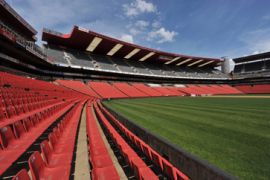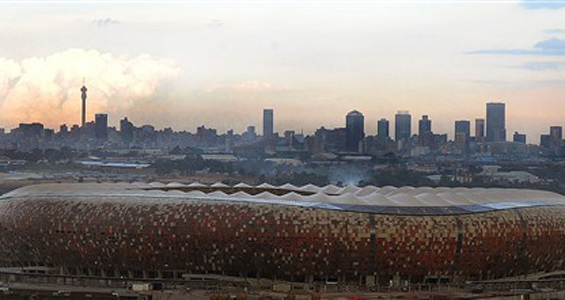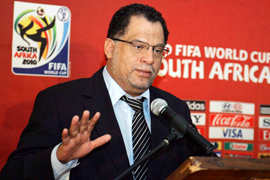Six months and counting
South Africa begins the historic countdown to football’s greatest show.

 |
| The Johannesburg skyline overlooks the Soccer City Stadium in Soweto [AFP] |
An iconic sporting stadium is emerging from African soil.
Designed to evoke the traditional calabash cooking pot, Johannesburg’s Soccer City is coming to the boil with time to spare.
This latest incarnation of a historic venue will host the first and final match of next year’s World Cup.
It was here in 1990 that Nelson Mandela addressed his first mass rally after being released from prison.
And here in 1996 that after years of sporting isolation the country lifted the Africa Cup of Nations.
Now after a $400m revamp, it is here that Africa’s first World Cup will begin in front of 90 thousand impassioned supporters.
Theatre of dreams
“It is a theatre of dreams for all South Africans,” says Danny Jordaan, the chief executive and public face of the host’s organising committee.
“For years the people of this country were brutalised and ostracised by the world, so to have this event is an affirmation of our human worth.
“South Africa is a developing country and Africa’s first World Cup host, but we are determined that this tournament should be amongst the best, if not the best, Fifa has ever seen.”
It is ambition that is not without consequence for Johannesburg’s people.
While Soccer City’s budget has continued to expand, they have seen public spending cut by more than $100m as a result. And work on the high speed rail link from Johannesburg airport is running out of time.
The $3.5bn project is unlikely to play even a partial World Cup role.
But all 10 stadia that will be used across the country are set to be ready in good time.
 |
| Jordaan hopes the World Cup will encourage lasting social change [GALLO/GETTY] |
The worker strikes that threatened preparations are now a fast fading memory.
Organisers talk of building a nation not just a few football grounds. They hope lasting social change will be this World Cup’s greatest legacy.
“People are working together because they want this World Cup to succeed,” says Jordaan.
“People aren’t working together because one is white and one is black. They are simply working together as South Africans.
“We have said that all must put on the yellow shirt of the South African team.
“Maybe then we’ll stop talking about black and white, and instead about the yellow nation that has achieved a miracle on this continent.”
The miracle that has been six years in the making, is now just six months away from actually happening.